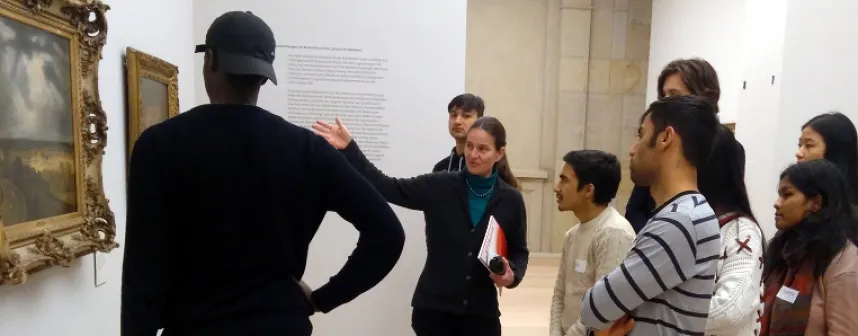A citizen of the world who builds bridges to art
March 2, 2018
She grew up in Dresden, studied in Moscow and taught in California. She speaks five languages and her research has an international focus. “I am at home in the world. This is why Jacobs University is such a great place for me,” says Dr. Isabel Wünsche, Professor in Art and Art History and one of the first researchers to join the campus in Bremen North.
She has been part of the International University Bremen, as it was called then, since its founding in August 2001. “There was a big table next to the President's Office where everyone gathered, there was just a few of us then,” she recalls. “If it was fully occupied and someone else came along, the youngest had to stand up and make room,” she says with a smile.
She had read about the founding of an international English-medium university in an advertisement. At the time, the art historian was teaching at the California Institute of Technology and a new start tempted her. Together with her husband, she sent in their applications – she as a professor and her husband for a position in the administration. Both started in Bremen and even acted as College Masters together, i.e. as contact and support persons for the 130 students of the pioneer generation.
The family atmosphere is still alive and well at Jacobs University, although the family has grown considerably larger. The art of the 19th and 20th centuries is the focal point of Isabel Wünsche's work; she is particularly interested in classical modernism and the concepts of avant-garde. “Here, it is not only about art, but the artists considered how they could redesign society; their work had social relevance.”
She is currently teaching “Art in Germany” for exchange students and the “Art in Context” course at Jacobs University. She and her students go to the museums in Bremen in order to learn more about works in painting, sculpture, graphic art and design from the late Middle Ages to the present day and the various theories of art history. “The students have a great deal of interest and I have some excellent doctoral candidates,” she says.
The students from over 100 countries are one of the reasons why she has been working at Jacobs University for 16 years now. Another is the close cooperation with colleagues. She does not feel like an outsider at the University that mostly specializes in technical and scientific subjects. After all, she attended a school in Dresden specializing in maths and physics before her art history studies in Berlin, Moscow, Heidelberg and Los Angeles. “I value the interdisciplinary cooperation highly as it encourages creativity.” Together with a statistician, an evolutionary biologist and a mathematician, she has offered courses on mathematical concepts in modern art as well as on creativity, biocentrism and modernism.
Her research has an international focus, too. She is currently working on the research project “Bauhaus in Australia” in collaboration with colleagues from Australia. She has just finished another project, the “Routledge Companion of Expressionism in a Transnational Context”, which will be published as a book this year. It deals with the reception of expressionism outside of the German-speaking world and is the result of a collaboration between 32 scientists from 25 countries.
More information:
http://iwuensche.user.jacobs-university.de
Questions will be answered by:
Dr. Isabel Wünsche | Professor of Art and Art History
i.wunsche [at] jacobs-university.de | Tel.: +49 421 200-3311
